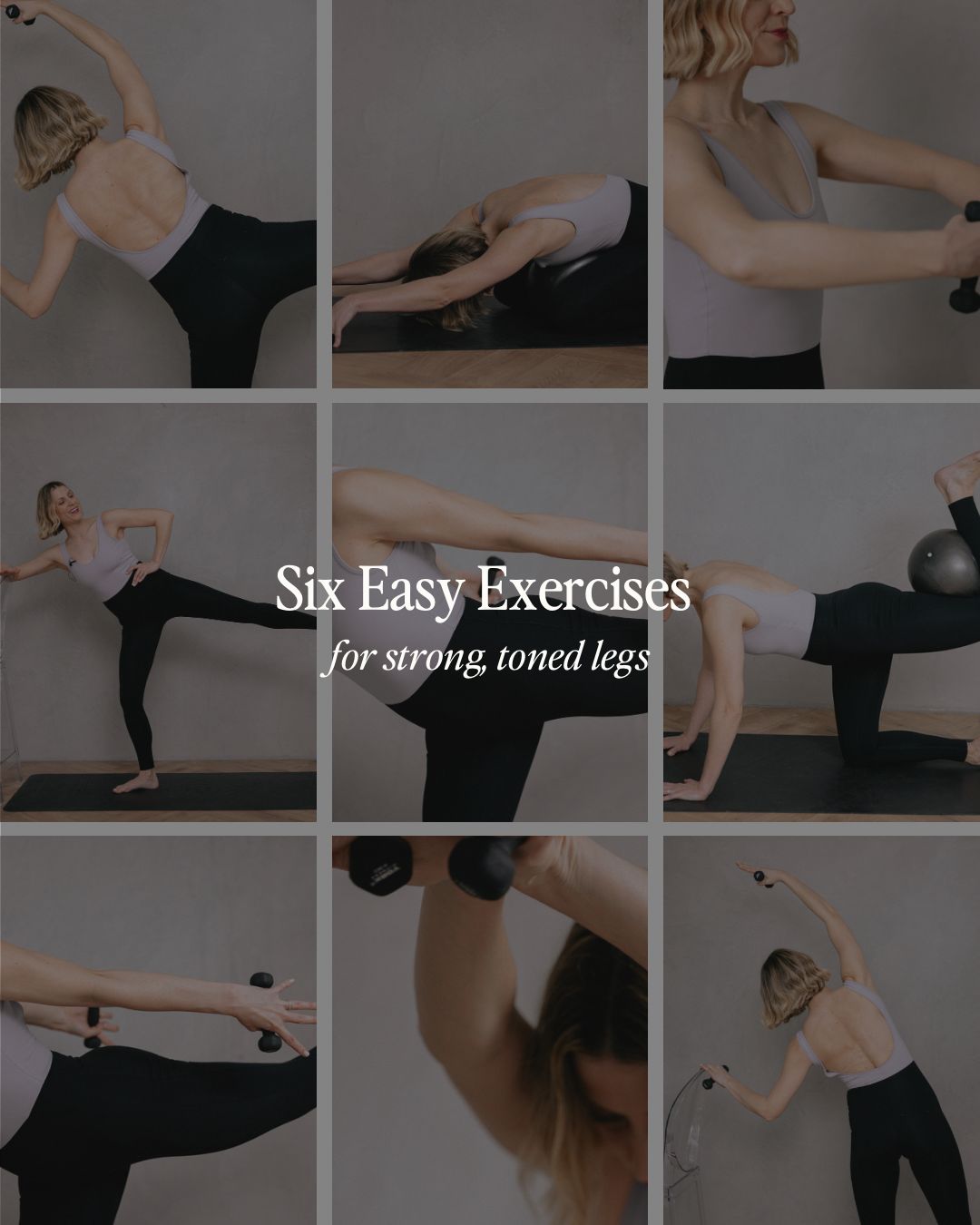
Six Easy Exercises: for strong, toned legs
April 15, 2024
Whether you’re looking to sculpt lean, strong legs or simply want to add some variety to your workout routine, we’ve got you covered. In this article, we’ll walk you through six highly effective exercises designed to target and tone those leg muscles. From classic barre exercises like calf raises to more focussed and concentrated exercises like external rotation, we’ll break down each exercise step by step, ensuring you get the most out of your workout. Plus, we’ll provide suggested repetitions to help you tailor your routine to your fitness level. Get ready to feel the burn and see results with these leg-toning exercises!
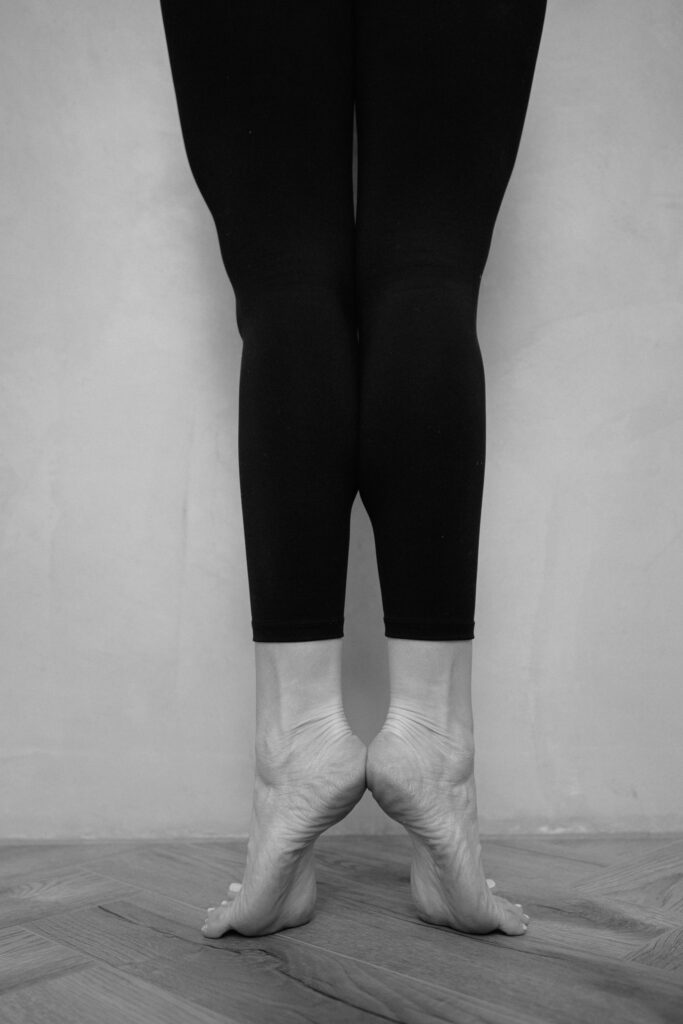
1. Calf Raises
Calf raises can help improve circulation by activating the calf muscles, which act as a pump to facilitate blood flow back to the heart. When you contract and relax these muscles during calf raises, it helps propel blood upwards, aiding in circulation throughout the body. Additionally, calf raises can strengthen the calf muscles, which can also support venous return and overall circulation in the legs.
To execute a calf rise from first position, begin by standing tall with your heels together and toes turned outwards, forming a “V” shape with your feet. Maintain a straight spine as you lift your heels off the ground, rising onto the balls of your feet, pressing all 10 toes into the ground. Keep your knees soft and aligned with your toes throughout the movement. At the top of the movement, pause briefly and contract your calf muscles before slowly lowering your heels back down to the starting position. Aim for controlled movements without any bouncing or jerking motions. To achieve progress in toning your calves, strive to perform 3 sets of 16 reps, ensuring proper form and focusing on the mind-muscle connection with each repetition. As you build strength and endurance, you can gradually increase the number of repetitions or sets to continue challenging your muscles effectively.
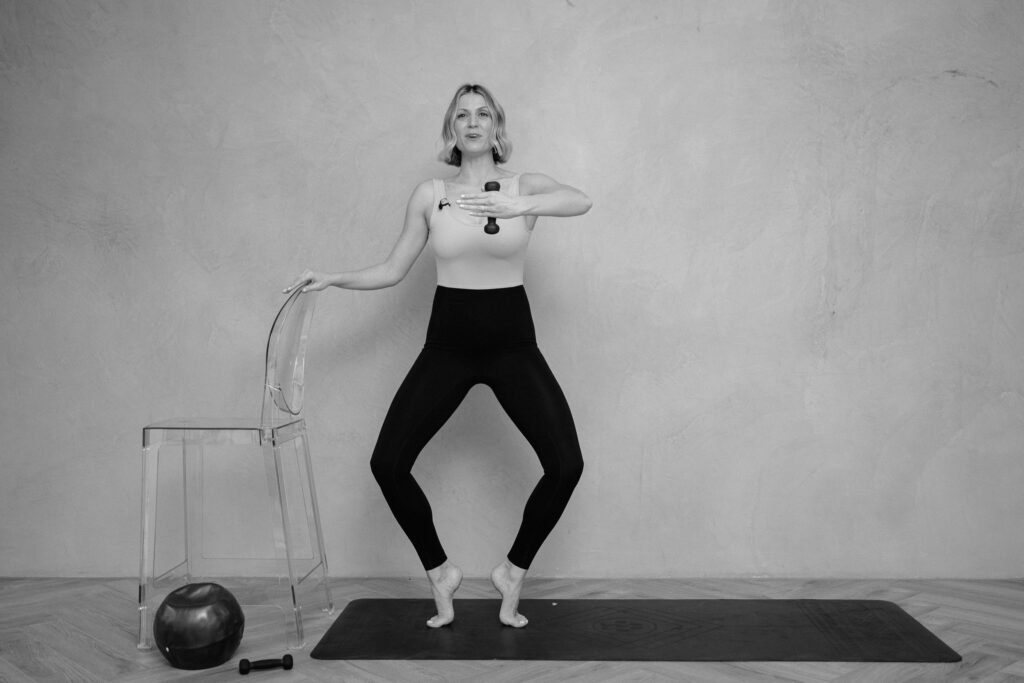
2. Pliés and external rotation of the hips
Pliés and external rotation of the hips are exercises commonly used in various fitness routines, including ballet, Pilates, and strength training, to target the glutes, thighs, and improve pelvic circulation. Here’s how these movements contribute to these benefits:
Glute activation: Pliés and external rotation of the hips engage the gluteal muscles, particularly the gluteus maximus, which is the largest muscle in the buttocks. When you perform these movements, especially in a controlled manner with proper form, your glute muscles contract to stabilise your hips and lower body. This repeated contraction helps to strengthen and tone the glutes over time.
Thigh engagement: Pliés involve bending the knees and lowering the body, which activates the quadriceps muscles (front of the thighs), hamstrings (back of the thighs), and adductor muscles (inner thighs). External rotation of the hips, when done with resistance or in a challenging position, also engages the muscles of the thighs, particularly the inner thigh muscles.
Pelvic circulation: Any exercise that engages the lower body, including pliés and external hip rotations, can help improve pelvic circulation. When you move your lower body muscles, blood flow increases to the pelvic region, which can have several benefits. Improved circulation helps deliver oxygen and nutrients to the pelvic organs, including the reproductive organs, and removes waste products more efficiently. This can contribute to overall pelvic health and may have additional benefits for menstrual health and sexual function.
To perform a plié from first position, start by standing tall with your heels together and toes turned outwards, forming a “V” shape with your feet. Begin to bend your knees into a diamond shape, lowering your body towards the ground while keeping your heels grounded. Make sure to track your knees over your 2nd and 3rd toe and keep your back straight. Aim to lower your body until you meet your challenge zone, or the position where you feel you can’t lower anymore without your heels peeling off the floor. Once you’ve reached the lowest point of the plié, press through your heels to rise back up to the starting position. For toning purposes, aim to perform 3 sets of 16 reps, focusing on controlled movements and proper form.
As you become more proficient, you can introduce a 16 count hold after each set and or pulses in your challenge zone.
For an added bonus, you may start to introduce an external rotation from your lowest point in your plie too! To perform the external rotation and once in the plié position, focus on actively squeezing the backs of your knees together to engage your abductor muscles. This inward squeezing motion targets the inner thighs and adds an additional challenge to the exercise. Continue this squeeze in a backward pulse motion for about 3 sets of 16 reps.
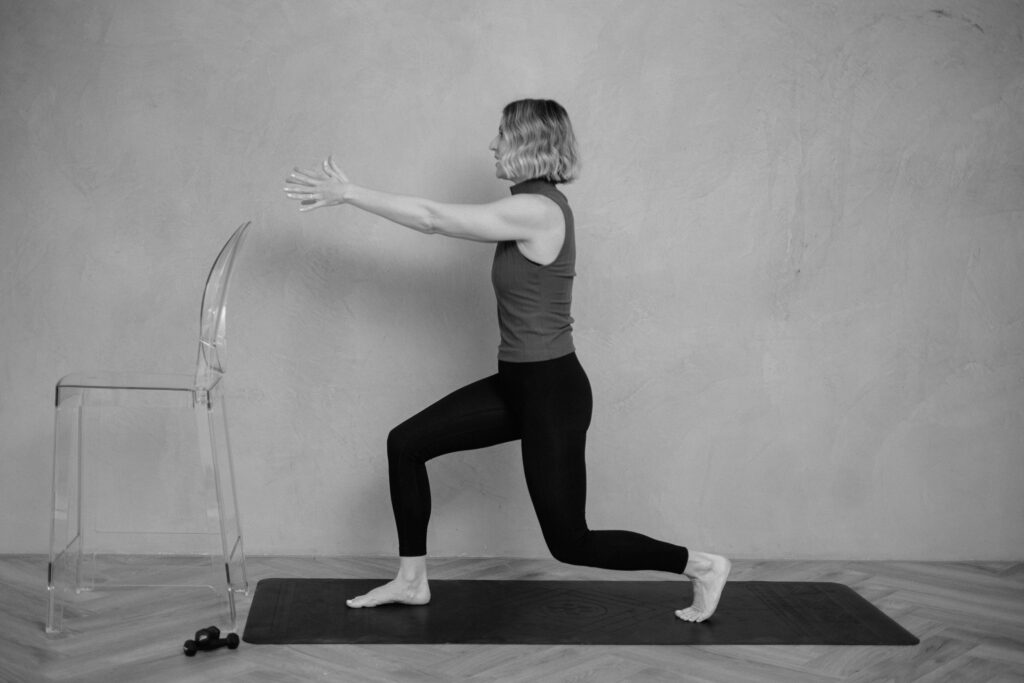
3. A reverse lunge
A reverse lunge challenges proprioception because it requires coordination, balance, and spatial awareness to perform the movement accurately.
Proprioception is your body’s ability to sense its position in space and the relative position of its various parts without relying on vision. It involves receptors in your muscles, tendons, and joints that send feedback to your brain about the position and movement of your body.
When you perform a reverse lunge, you’re stepping backward with one leg while keeping your balance and stability. This movement requires your proprioceptive system to adjust and maintain your body’s position in space as you move through the exercise. Your body needs to sense the position of your limbs, especially the moving leg, and make continuous adjustments to maintain balance and stability throughout the movement.
Additionally, reverse lunges often involve a deeper range of motion compared to forward lunges, which further challenges your proprioceptive abilities. This increased range of motion requires greater coordination and control to execute the movement smoothly without losing balance or stability.
By incorporating exercises like reverse lunges into your routine, you can improve your proprioception over time, which can enhance your overall balance, coordination, and functional movement abilities.
Start by standing tall with your feet hip-width apart and your hands on your hips or by your sides. Take a step backward with one foot, lowering your body until both knees are bent at approximately 90-degree angles. Make sure your front knee is aligned with your ankle and doesn’t extend past your toes. Keep your torso upright and engage your core for stability. Push through the heel of your front foot to return to the starting position. Alternate legs and repeat the movement. Aim to perform 3 sets of 16 reps on each leg, focusing on controlled movements and proper form.
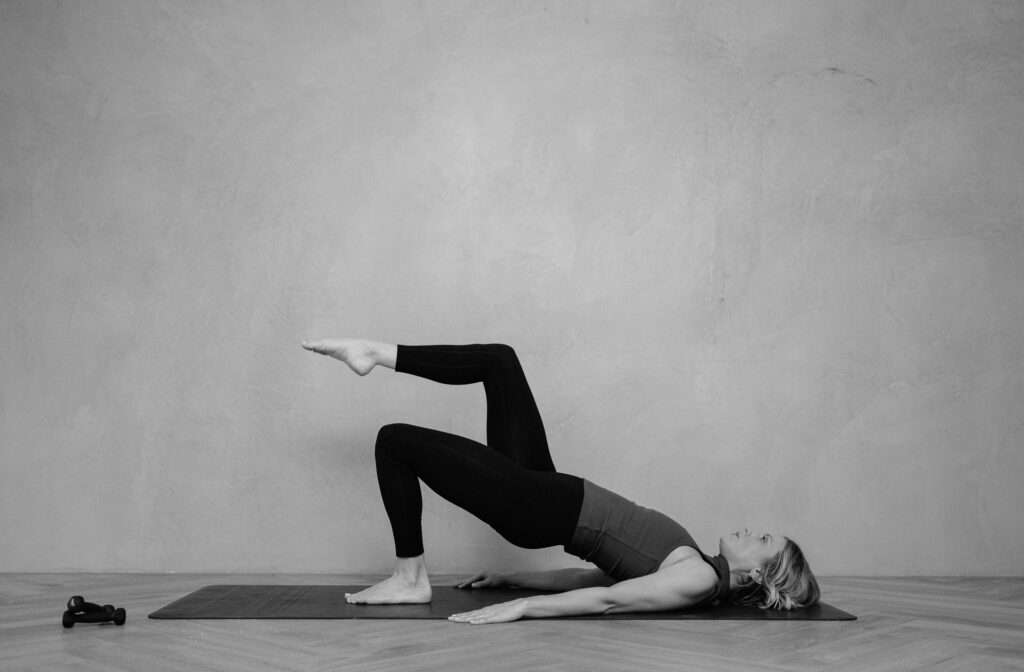
4. Glute bridges
Glute bridges are an effective exercise for targeting the glutes while also engaging and strengthening a variety of muscles in the lower body, including the pelvic floor muscles, hamstrings, lower back, and core.
- Gluteal muscles: Glute bridges directly target and activate the gluteal muscles, particularly the gluteus maximus. When you lift your hips off the ground during the bridge movement, the gluteus maximus contracts to extend your hips and lift your body upward.
- Pelvic floor muscles: The pelvic floor muscles are a group of muscles located at the base of the pelvis that support the pelvic organs, including the bladder and uterus. When you perform a glute bridge, especially if you engage your core and pelvic floor muscles throughout the movement, there is increased activation of the pelvic floor muscles to stabilise the pelvis and maintain proper alignment. This activation helps improve pelvic floor strength and function, which can be beneficial for pelvic health and stability.
- Hamstrings: While the gluteal muscles are the primary movers in the glute bridge, the hamstrings also play a secondary role in hip extension. As you lift your hips off the ground, the hamstrings contract to assist the glutes in extending the hips and straightening the legs.
- Lower back muscles: The erector spinae muscles of the lower back are also engaged to stabilise the spine during the glute bridge movement. These muscles work isometrically to keep the spine in a neutral position as you lift and lower your hips.
- Core muscles: The core muscles, including the rectus abdominis, obliques, and transverse abdominis, are activated to stabilise the trunk and pelvis during the glute bridge movement. Engaging the core helps maintain proper alignment of the spine and pelvis, reducing the risk of lower back strain and injury.
To perform a glute bridge, begin by lying on your back with your knees bent and feet flat on the floor, hip-width apart. Keep your arms relaxed by your sides with palms facing down. Engage your core muscles to stabilise your spine. Press through your heels and lift your hips towards the ceiling, squeezing your glutes at the top of the movement. Ensure your body forms a straight line from your shoulders to your knees at the peak of the bridge. Hold for a moment, then slowly lower your hips back down to the starting position, maintaining control throughout the movement. Aim to perform 3 sets of 16 reps, focusing on the contraction of your glutes and maintaining proper form.
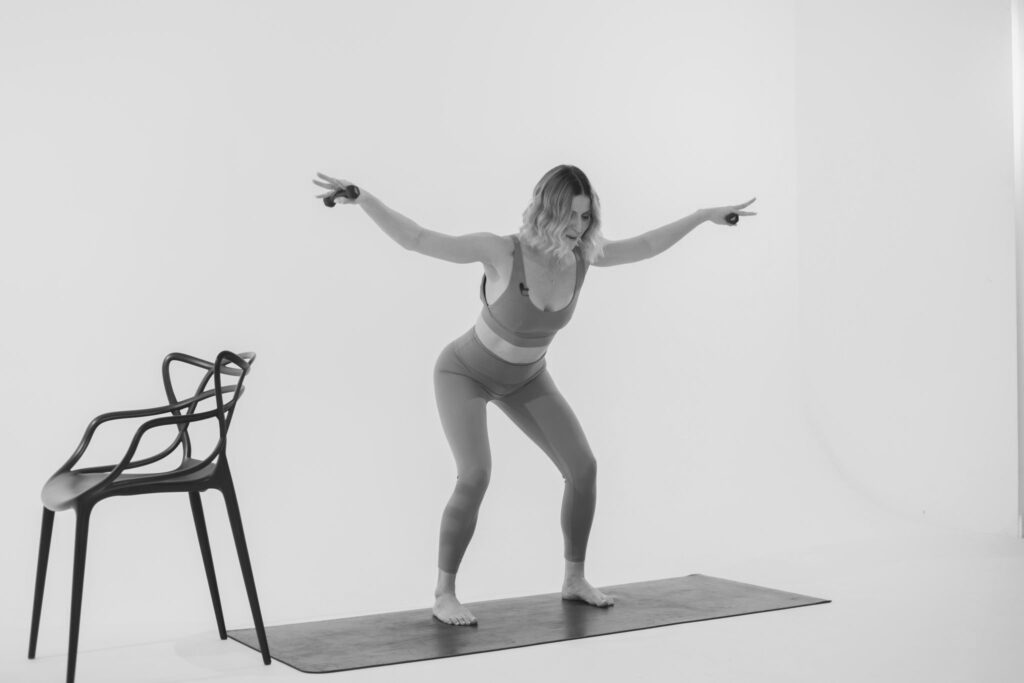
5. Squats
Squats. Working the hips in parallel refers to maintaining alignment and stability in the hip joints during exercises or movements. This alignment is important for several reasons:
- Muscle Activation: Working the hips in parallel helps ensure that the muscles surrounding the hips, including the glutes, quadriceps, hamstrings, and adductors, are engaged optimally. When the hips are in proper alignment, these muscles can work together efficiently to perform movements with proper form and function.
- Joint Health: Keeping the hips in parallel reduces the risk of strain or injury to the hip joints. Misalignment or excessive rotation of the hips can put stress on the hip joint and surrounding structures, potentially leading to discomfort or injury over time.
- Spinal Alignment: Proper alignment of the hips also contributes to overall spinal alignment. When the hips are in parallel, it helps maintain a neutral spine, reducing the risk of lower back pain or injury during movements.
- Balance and Stability: Working the hips in parallel improves balance and stability during exercises and functional movements. This is particularly important for activities that require weight-bearing on one leg or movements that involve shifting weight from side to side.
Regarding the overall benefits of a squat, here are some key points:
- Strengthens Lower Body: Squats are a compound exercise that target multiple muscles in the lower body, including the quadriceps, hamstrings, glutes, and calves. Performing squats regularly can help increase strength and muscle mass in these areas.
- Improves Functional Movement: Squats mimic movements that are common in daily activities, such as sitting down and standing up, making them a functional exercise. By strengthening the muscles involved in these movements, squats can improve overall functional movement and mobility.
- Enhances Core Strength: Squats require core stabilisation to maintain proper form and balance. As a result, squats can help strengthen the muscles of the core, including the abdominals, obliques, and lower back muscles.
- Increases Joint Flexibility: Squats involve bending at the hips, knees, and ankles, which helps improve joint flexibility and range of motion in the lower body. Over time, regular squatting can contribute to better flexibility and mobility in these joints.
- Boosts Metabolism: Squats are a compound, multi-joint exercise that recruit a large number of muscles. Performing squats with proper intensity can elevate heart rate and metabolism, contributing to calorie burning and weight management goals.
Overall, incorporating squats into your exercise routine can offer a wide range of benefits for strength, mobility, and overall health.
Standing with your feet shoulder-width apart, toes slightly turned outwards. Engage your core muscles and keep your chest lifted as you bend your knees and lower your hips back and down as if you’re sitting into an imaginary chair. Keep your weight in your heels and ensure your knees track over your toes. Aim to lower down until your thighs are parallel to the ground, or as low as comfortably possible while maintaining proper form. Press through your heels to return to the starting position, squeezing your glutes at the top of the movement. Aim to perform 3 sets of 10-12 reps, focusing on controlled movements and maintaining proper form throughout each repetition.
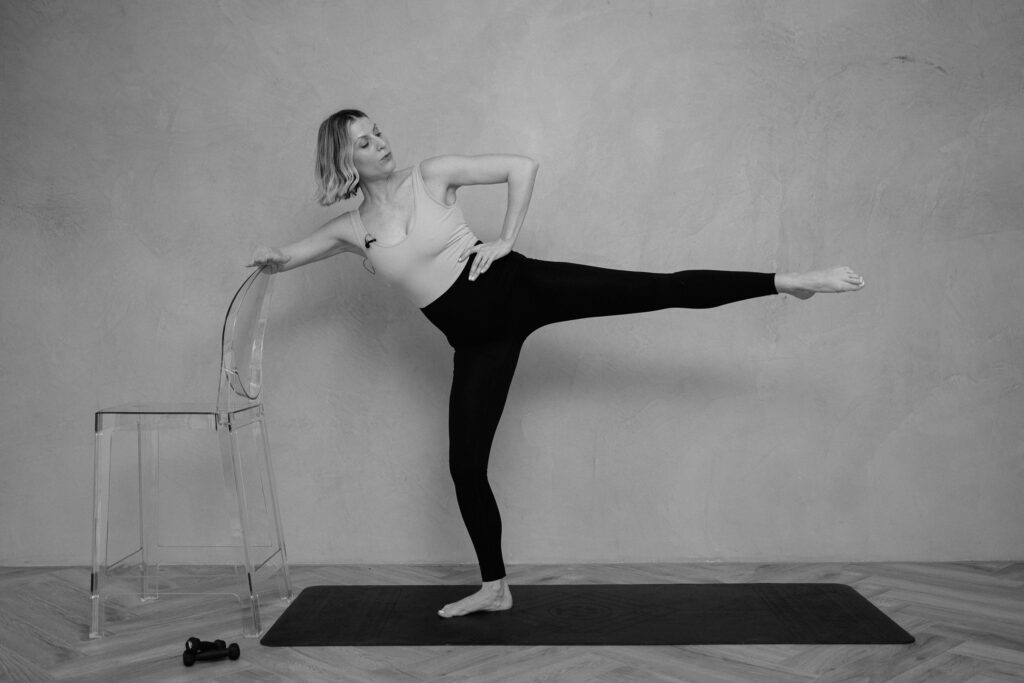
6. Side Leg Lifts
Side Leg Lifts
- Targeting Specific Muscles: Side leg lifts primarily target the muscles on the side of the hip, including the gluteus medius and minimus, as well as the tensor fasciae latae. These muscles are important for hip stability and abduction (moving the leg away from the midline of the body). Strengthening these muscles can help improve hip stability, balance, and overall lower body strength.
- Improving Hip Mobility: Side leg lifts help improve hip mobility by working through the range of motion of abduction and adduction (moving the leg away from and towards the midline of the body). This can be particularly beneficial for individuals who have tight hips or limited range of motion in the hip joint.
- Enhancing Core Stability: Performing side leg lifts requires engaging the core muscles to stabilise the torso and pelvis. This helps improve core stability and control, which is important for maintaining proper posture and alignment during various activities and exercises.
- Preventing Injury: Strengthening the muscles involved in hip abduction can help prevent injuries, especially in the hips and knees. Weakness in the hip abductor muscles can contribute to issues such as IT band syndrome, hip bursitis, and knee pain. By strengthening these muscles, side leg lifts can help reduce the risk of these injuries.
- Functional Movement: Side leg lifts mimic movements that are important for everyday activities, such as walking, climbing stairs, and standing from a seated position. By strengthening the muscles involved in these movements, side leg lifts can improve functional movement patterns and make daily activities easier and more efficient.
Overall, incorporating side leg lifts into your workout routine can help improve hip strength, mobility, and stability, leading to better overall lower body function and reducing the risk of injury.
To perform a slide leg lift from first position, start by standing tall with your heels together and toes turned outwards, forming a “V” shape with your feet. Extend one leg out to the side, keeping it straight and in line with your hip. Place your elbow on a barre or bench for support and stability. Bend and soften your standing knee for safety and stability. Then, initiate the side leg lift by driving through the pinky toe of your extended leg, lifting it up towards the ceiling while keeping it straight. Focus on engaging the muscles along the side of your hip and thigh (abductors) as you lift the leg. Hold for a brief moment at the top of the movement, then lower it back down with control. Aim to perform 3 sets of 16 reps on each side, ensuring smooth and controlled movements throughout. As an added challenge, you may add 16 pulses at the top before completing a single set.
Leave a Reply Cancel reply
Copyright © 2022 CatieMiller.Co Ltd (Company registered in England and Wales with Company Number: 14299972. Trading as Barre Series.
Legal bits
Back to the top
CONTACT
why barre?
Info
FAQS
THE EDIT
Quick links
ONLINE CLASSES
STUDIO CLASSES
Classes
Connect with us on socials
SIgn UP TO THE barre series newsletter
Site made by Rove